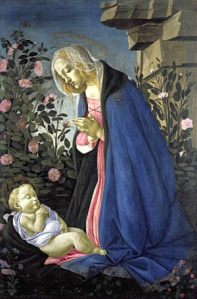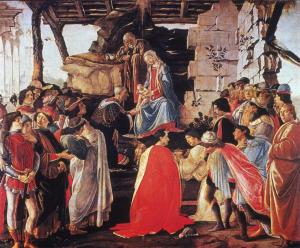Living and working during the
same time as greats like Michelangelo and Leonardo Da Vinci, it would be
easy for even a great artist like Botticelli to get lost in that crowd
Alessandro Filipepi, known as Sandro Botticelli, (1444-1510) began
his career during the Italian Renaissance period. Botticelli was born in
Florence around 1445 where he would live out the rest of his life. As
the youngest of five children, Botticelli’s father, a tanner, allowed
him to become an apprentice to a goldsmith. During this apprenticeship,
the goldsmith he worked with gave him the name Botticelli, meaning
‘little barrel.’

After a time, Sandro convinced his father that he wanted to study painting and was chosen to be apprentice to the well known painter Fra Filippo Lippi. Lippi was well known for how he used color on church altarpieces and helped Sandro discover a similar style for his own work. Sandro Botticelli developed tender expressions in his subjects face and in their gestures. He also used decorative details that were influenced by his training. Botticelli quickly became recognized as a gifted artist all by himself. By the time he was 15 years old, he was able to open a workshop dedicated to his own work.
In Sandro Botticelli’s workshop, he chose to have many apprentices to help him complete his work. Sandro taught them to set up and prepare his supplies so he could concentrate on painting. When Sandro thought one of his apprentices was ready, he had some of them paint for him under his close supervision. Using these practices, he was able to produce large amounts of commissioned work.

Botticelli’s style evolved into one that was very distinct. His portraits seemed to have a melancholy or sad characteristic to them. Sandro stressed line and detail using them to bring his characters alive – as if acting out a scene. He included in his style a flowing characteristic that would clearly identify work as his. Botticelli also included Neoplatonism in his work. This meant that he would bring together in one painting ideas that belong to both Christianity and pagan ideas which may have included mythology. One theme that Botticelli used over and over again was the idea of a very sad young girl that was detached from what was going on around her. This theme appeared in many of his portraits throughout his career. Another theme Botticelli liked tackling were the roles male and females played in society. Sometimes Sandro would show traditional roles, but other times, he showed females as the dominant, most important figure.

Sandro Botticelli’s work was most in demand by the Medici family. The Medici’s were a very rich and prominent member of the Florence society. Botticelli is thought to have used them as subjects for a large number of his works. They traveled in very important circles and introduced Botticelli to some of the most influential people. In these different settings, Sandro gathered material to use in his portraits and scene portrayals. The Medici family would pay huge sums of money for Botticelli’s work.
In 1481, Botticelli was invited to Rome to take part in the painting of the Sistine Chapel. Sandro joined artists such as Perugino, Ghirlandaio and then Michelangelo in contributing to the most well known piece of Italian art. While there, Botticelli worked on several pieces in the Chapel. In all, Botticelli painted three large pieces, as well as seven papal portraits in the Sistine Chapel.

As Sandro grew older, his style underwent a remarkable change. Sandro became a follower of the monk Savonarola who was a prominent civic leader in Florence. He stressed giving up all worldly things. He was very charismatic and often spoke of death and God’s wrath upon the people. Many of Botticelli’s previous paintings were considered ungodly and were burned along with objectionable books and playing cards. When Savonarola’s popularity ended, he was burnt in the center of Florence. Many followers fled the city, but Botticelli stayed and continued to paint. Many of his works contained a very religious feel to them. Sandro included highly religious symbolism in his paintings; they seemed to be telling a story. Sandro became known as an excellent altarpiece painter and earned large amounts of money through those commissions.

Botticelli’s later years seemed to be a disturbing time for him. As times changed in Florence, Botticelli tried to keep up. He often took on difficult commissions that other painters turned down. His rotating style reflected that Botticelli was struggling as a painter. His paintings were full of emotion raging from violence to grace and compassion.
Even though Sandro was trying to keep up his status as a painter, he was still recognized with the honor to be part of the committee that chose the spot where Michelangelo would place his statue David.

Sandro Botticelli died at the age of 65. Some say Sandro was poor and unaccomplished at his death. This could be attributed to the rising popularity of new and contemporary artists such as Michelangelo, Raphael and Leonardo Da Vinci. Even though his work is now thought to be among the most masterful of his time, his work lay forgotten for over 400 years after his death. Looking back at history, he now has the respect he earned through a lifetime of achievement. Sandro Botticelli contribution to the Italian Renaissance period was one of great distinction.

After a time, Sandro convinced his father that he wanted to study painting and was chosen to be apprentice to the well known painter Fra Filippo Lippi. Lippi was well known for how he used color on church altarpieces and helped Sandro discover a similar style for his own work. Sandro Botticelli developed tender expressions in his subjects face and in their gestures. He also used decorative details that were influenced by his training. Botticelli quickly became recognized as a gifted artist all by himself. By the time he was 15 years old, he was able to open a workshop dedicated to his own work.
In Sandro Botticelli’s workshop, he chose to have many apprentices to help him complete his work. Sandro taught them to set up and prepare his supplies so he could concentrate on painting. When Sandro thought one of his apprentices was ready, he had some of them paint for him under his close supervision. Using these practices, he was able to produce large amounts of commissioned work.

Botticelli’s style evolved into one that was very distinct. His portraits seemed to have a melancholy or sad characteristic to them. Sandro stressed line and detail using them to bring his characters alive – as if acting out a scene. He included in his style a flowing characteristic that would clearly identify work as his. Botticelli also included Neoplatonism in his work. This meant that he would bring together in one painting ideas that belong to both Christianity and pagan ideas which may have included mythology. One theme that Botticelli used over and over again was the idea of a very sad young girl that was detached from what was going on around her. This theme appeared in many of his portraits throughout his career. Another theme Botticelli liked tackling were the roles male and females played in society. Sometimes Sandro would show traditional roles, but other times, he showed females as the dominant, most important figure.

Sandro Botticelli’s work was most in demand by the Medici family. The Medici’s were a very rich and prominent member of the Florence society. Botticelli is thought to have used them as subjects for a large number of his works. They traveled in very important circles and introduced Botticelli to some of the most influential people. In these different settings, Sandro gathered material to use in his portraits and scene portrayals. The Medici family would pay huge sums of money for Botticelli’s work.
In 1481, Botticelli was invited to Rome to take part in the painting of the Sistine Chapel. Sandro joined artists such as Perugino, Ghirlandaio and then Michelangelo in contributing to the most well known piece of Italian art. While there, Botticelli worked on several pieces in the Chapel. In all, Botticelli painted three large pieces, as well as seven papal portraits in the Sistine Chapel.

As Sandro grew older, his style underwent a remarkable change. Sandro became a follower of the monk Savonarola who was a prominent civic leader in Florence. He stressed giving up all worldly things. He was very charismatic and often spoke of death and God’s wrath upon the people. Many of Botticelli’s previous paintings were considered ungodly and were burned along with objectionable books and playing cards. When Savonarola’s popularity ended, he was burnt in the center of Florence. Many followers fled the city, but Botticelli stayed and continued to paint. Many of his works contained a very religious feel to them. Sandro included highly religious symbolism in his paintings; they seemed to be telling a story. Sandro became known as an excellent altarpiece painter and earned large amounts of money through those commissions.

Botticelli’s later years seemed to be a disturbing time for him. As times changed in Florence, Botticelli tried to keep up. He often took on difficult commissions that other painters turned down. His rotating style reflected that Botticelli was struggling as a painter. His paintings were full of emotion raging from violence to grace and compassion.
Even though Sandro was trying to keep up his status as a painter, he was still recognized with the honor to be part of the committee that chose the spot where Michelangelo would place his statue David.

Sandro Botticelli died at the age of 65. Some say Sandro was poor and unaccomplished at his death. This could be attributed to the rising popularity of new and contemporary artists such as Michelangelo, Raphael and Leonardo Da Vinci. Even though his work is now thought to be among the most masterful of his time, his work lay forgotten for over 400 years after his death. Looking back at history, he now has the respect he earned through a lifetime of achievement. Sandro Botticelli contribution to the Italian Renaissance period was one of great distinction.
No comments:
Post a Comment